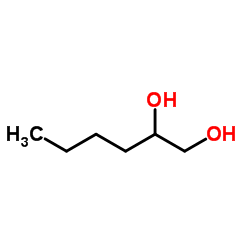Hexane-1,2-diol

Hexane-1,2-diol structure
|
Common Name | Hexane-1,2-diol | ||
|---|---|---|---|---|
| CAS Number | 6920-22-5 | Molecular Weight | 118.174 | |
| Density | 1.0±0.1 g/cm3 | Boiling Point | 223.5±0.0 °C at 760 mmHg | |
| Molecular Formula | C6H14O2 | Melting Point | 45ºC | |
| MSDS | Chinese USA | Flash Point | 95.8±13.0 °C | |
| Symbol |

GHS07 |
Signal Word | Warning | |
|
Removal of lipopolysaccharides from protein-lipopolysaccharide complexes by nonflammable solvents.
J. Chromatogr. B. Analyt. Technol. Biomed. Life Sci. 816(1-2) , 167-74, (2005) During the recovery of recombinant proteins from gram negative bacteria, many of the methods used to extract proteins from cells release lipopolysaccharides (LPS, endotoxin) along with the protein of interest. In many instances, LPS will co-purify with the ta... |
|
|
Inhibition of N-methyl-D-aspartate receptors by straight-chain diols: implications for the mechanism of the alcohol cutoff effect.
Mol. Pharmacol. 61(1) , 169-76, (2002) n-Alkanol inhibition of N-methyl-D-aspartate (NMDA) receptors exhibits a "cutoff" effect: alcohols with up to eight to nine carbon atoms inhibit the receptor, whereas larger alcohols do not. This phenomenon was originally proposed to result from size exclusio... |
|
|
Protein engineering of a thermostable polyol dehydrogenase.
Enzyme Microb. Technol. 51(4) , 217-24, (2012) The polyol dehydrogenase PDH-11300 from Deinococcus geothermalis was cloned, functionally expressed in Escherichia coli and biochemically characterized. The enzyme showed the highest activity in the oxidation of xylitol and 1,2-hexanediol and had an optimum t... |
|
|
Modification of a micellar system for amino acid separation by MEKC--application for amino acid profiling in formulations for parenteral use.
Talanta 83(2) , 513-20, (2010) The paper proposes a new method for amino acid determination which can be applied for amino acid profiling in solutions for parenteral nutrition. The MEKC method based on a mixed micellar system was developed for the separation of 6-aminoquinolyl-N-hydroxysuc... |
|
|
Effects of alcohols and diols on the phase behaviour of quaternary systems.
Int. J. Pharm. 196(2) , 141-5, (2000) The aim of the current study was to investigate the effect of different co-surfactants on the phase behaviour of the pseudoternary system water:ethyl oleate:nonionic surfactant blend (sorbitan monolaurate/polyoxyethylene 20 sorbitan mono-oleate). Four aliphat... |
|
|
Profiling isoflavonoids found in legume root extracts using capillary electrophoresis.
Electrophoresis 23(11) , 1642-51, (2002) Legumes such as alfalfa (Medicago sativa L.), barrel medic (Medicago truncatula), white sweet clover (Melilotus alba) and fenugreek (Trigonella graecum), normally accumulate (-)-medicarpin and its malonated glucose conjugate as natural inhibitors of fungal pa... |
|
|
The efficiency of humectants as skin moisturizers in the presence of oil.
Skin Res. Technol. 7(1) , 32-5, (2001) The research on the treatment of "dry skin syndrome" is hampered by the lack of a suitable animal model. Formerly, we developed a validated guinea pig in vivo model in which the dry skin syndrome persists at least for 1 week. We can, therefore, compare the ph... |
|
|
Synergistic effect of 1,4-cyclohexanediol and 1,2-hexanediol on percutaneous absorption and penetration of metronidazole.
Int. J. Pharm. 415(1-2) , 169-74, (2011) The objective of this study was to investigate the percutaneous absorption of metronidazole (MTZ) in the topical formulations containing a combination of 1,4-cyclohexanediol and 1,2-hexanediol. Six formulations were studied in an in vitro hairless mouse skin ... |
|
|
Explorations of alkyl polyols as "class I" organic modifiers to adjust selectivity in micellar electrokinetic capillary chromatography.
Electrophoresis 20(12) , 2390-9, (1999) In this study, we investigated a novel series of micelle modifiers useful to alter selectivity in micellar electrokinetic capillary chromatography (MEKC). These modifiers were alkyl polyalcohols, including 1-octanol, 1,2-octanediol, 1,2,3-octanetriol, 1,2-hex... |
|
|
Adjusting selectivity in micellar electrokinetic capillary chromatography with 1,2-hexanediol.
Electrophoresis 20(1) , 100-10, (1999) In this report, we introduce a new micelle modifier useful to alter selectivity in micellar electrokinetic capillary chromatography (MECC). 1,2-Hexanediol acts as a class I organic modifier in that its effects are on the sodium dodecyl sulfate (SDS) micellar ... |